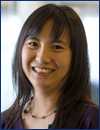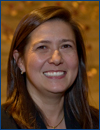Hi everyone! Today, we want to share with you a story about how the programs funded by the CTE Pathways Initiative (SB70) impact non-CTE teachers – in this case, Senna Davis, a science teacher at Sacramento New Technology High School. This post is longer and more detailed than our usual posts, but we thought you might find it interesting to see exactly what happens in a core academic content classroom, after a teacher has experienced an externship program. We hope you find this story as exciting and encouraging as we did.
What’s the toughest challenge facing teachers today? Most of them will tell you that it’s the fact that their classes are filled with disengaged and unmotivated students. CTE teachers have long known that to get students excited and interested in what they’re learning, you need to show them how content is 1) related to their own lives and/or 2) how it actually impacts the “real world.” But it’s not just CTE teachers that understand this. There are more and more educators–teaching core academic content from K-12 to college–who believe that contextualizing content in authentic and compelling ways can lead to a better learning (and teaching) experience for all. Senna Davis, a science teacher at Sacramento New Technology High School, is one of these educators, and when a colleague told her about the Sacramento-Yolo Educator Externship Program, Davis decided she’d look into it. She brought the opportunity to her school administrators, and with their wholehearted support, she applied and was accepted to participate.
The Nuts & Bolts
The Sacramento-Yolo Educator Externship Program is structured to pair an educator with an industry employer for 40 hours during the summer. The program has a strong partner in the North State Building Industry Association, which assists in recruiting construction, engineering, architecture, utilities, and other types of employers with whom educators are placed.
Prior to the actual externship itself, teachers and counselors who are participating attend an orientation meeting where they learn how the program works and what will be required of them. Then, sometime in June or July, the actual externship–the time spent “on the job” at the assigned industry site–takes place. This is followed by a 2-day work session in August, where the educators come together to share and develop lesson plans. This is where some externship programs leave off. Not so, in the case of the Sacramento-Yolo Educator Externship Program.
In the fall, with the start of the school year, teachers and counselors are tasked with actually implementing their externship-developed lesson plans. Students are asked to evaluate the lessons or guidance services they received from teachers and counselors. In early December, there’s a final meeting where students, teachers, and counselors all come together to reflect on and celebrate their experiences.
It sounds like quite a time commitment, doesn’t it? It is. But it’s not work that’s done “for free.” There’s a healthy stipend attached to participation in the externship–about 30% of which participants receive at the start of the externship, and the final 70% at the end, after completing all the requirements. Davis appreciated this, noting that it made her feel all the more respected as a professional.
And in the Case of Our Brave Science Teacher
Davis was placed with the City of Sacramento’s Department of Utilities, working specifically with Doug Houston, Neighborhood Resource Coordinator. The time spent with Houston turned out to be invaluable. Not only did he teach her about the various types of work handled by the Department of Utilities–things like garbage pick-up and processing, water, street cleaning, and recycling–but he introduced her to or put her in contact with people throughout the department and beyond, facilitating her ability to seek out and access community and industry resources.
Davis notes that even though she works at a school that incorporates project based learning (PBL) as its primary instructional method, she still finds it challenging to design educational projects that are authentic and “real world” while simultaneously covering California content standards. Being able to talk with people who are out there, actually doing the work, has really made a difference for her as an educator and, as a result, her students. Prior to the externship, she admits she wouldn’t have been as likely to reach out to the community to ask for help and resources. It was the externship that made her realize that doing so wasn’t the frustrating or overwhelming thing she’d imagined; in fact, all the people she spoke with were eager to help. Keeping that in mind, she’s now more willing to cold call local businesses and organizations, and more often than not, she gets the same eager response.
Case in point? Just a couple weeks ago, she called a local appliance retailer to ask if they might allow her students to come into their showroom and measure the energy efficiency of the appliances. Not only did the business welcome Davis and her students, they expressed an interest in hearing about and publicizing anything students might discover.
Houston also helped Davis broaden her understanding of the social aspects of applied science–introducing her to the impact of legislation and policy-making on the department’s responsibilities and discussing the challenges the department faces in convincing residents to change their behaviors regarding waste disposal. “I’d never thought about politics and policies before. I’m a scientist,” she explained. It quickly became clear to her, however, what a large role policies have in the way science gets applied. These perspectives became the compelling focus of the lesson plans she developed for the externship.

Sacramento New Tech High students present on vermicomposting to community members at a local health fair.
Taking It Back to the Classroom (And Beyond)
Davis teaches two subjects – biology and chemistry, so she decided to come up with at least two sets of lesson plans. Houston helped out by coming in to speak with her students about the work and challenges of the Department of Utilities. When he presented some proposed legislation that would require an 80% reduction of landfill waste by 2020, and a 100% reduction – or zero waste – by 2040, her biology students were floored. Was it even possible? They decided to investigate ways to make progress towards these goals, starting with their own school.
What they came up with? Worms. Specifically, a type of composting that uses worms to break down food waste, called vermicomposting.
Davis was able to successfully apply for and receive a small grant (one that she learned about from Houston) that allowed her to buy materials for the vermicomposting project, including bins for the campus, books, worms, water bottles, etc. The biology students set up the bins and made presentations to the student body, explaining what they were for and how they worked. As a group, they maintained the composting bins for a whole semester, and when the semester ended, the project was passed on to the next group of biology students.
Aside from being a great learning opportunity for students, the vermicomposting project has led to a drastic reduction in waste produced by the school – a “real world” outcome that students can see and feel for themselves.
Davis’s chemistry students also decided to look at waste management issues, but they utilized a different approach. Davis took her students, split into two groups of 30-40 each, to visit the transfer station (more commonly known as the city dump) so the students could see for themselves the enormous amount of garbage that is trucked in from the city every day.
In case you’re wondering, she and the students took public transportation (city buses) and nearly all but about 10 of her 78 students were able to go. The kids paid their fare themselves, though Davis did have access to a small “science fund” to help pay the $2 bus fare in the case of students who didn’t have access to a bus pass or money of their own. Using public transportation hugely reduced the financial burden that school field trips can often become.
Davis and her chemistry students settled on the issue of “green waste” as their topic of study. “Green waste” is the term applied to yard clippings–grass, leaves, weeds, and other organic waste that gets discarded after yard work. Sacramento is a river city, so anything that gets into the storm drains will eventually end up in the river. Why is this a problem, you ask? Well, it turns out that green waste is a pollutant of real concern, impacting the pH levels of the water, solubility, and introducing heavy metals and pesticides into the river, which can cause serious problems for the fish and wildlife. Sacramento New Tech High chemistry students evaluated the effects of not using the bins and the consequences of polluting the river. The river provides drinking water for the city, so water filtering and cleaning processes are complicated by the greater amounts of pollution. In addition to experiencing the process of cleaning water firsthand, they developed a promotional video persuading residents to use the Green Waste Bins the city provides (you can see it here).
In addition to all of this, Davis also sponsored a “Reusable Usable Art” fair for her students. Students were tasked with creating functional pieces of art from repurposed or recycled items. Students were reminded to consider elements such as human comfort, ease of use, pollution, and other issues when creating their artwork.

Sacramento New Tech High students, Pablo Ortega, Jose Manzo, Michael Carter-Morse and Principal Paula Hanzel with Reusable Usable Art project, the "Skateboard Chair."
Other Takeaways
Davis credits the externship for infusing new energy into her work and for introducing her to the idea of teaching chemistry, biology, and math through the lens of meeting social needs. The experiences afforded by the externship have changed the way she sees her students as well. “The kids really rose to the occasion,” she said, describing how they impressed her when they met with Doug Houston and on the trip to the transfer station. They acted professionally, asked good questions, and interacted well with the people they met. Witnessing her students engage with both content and community this way has broadened her perspective on the kinds of work and learning they’re able to do.
Would she recommend the externship to other teachers? Davis’s answer was a resounding, “Yes!” In fact, she’s planning to apply for a second year, as teachers are allowed to participate for up to two sessions. She’s hoping to get to work with another industry–maybe SMUD (Sacramento Municipal Utility District, the energy company) or a construction firm. Davis notes that while many of the industries seem more geared toward science and math teachers, she knows an English teacher who participated in and benefitted from the program.
She summed it up, succinctly: “It’s really been great, what they’ve done for us.”
The materials and lesson plans she and other participating educators have developed are available as a free resource for interested educators and the public. For more information about this externship program, contact Torence Powell, Director of GreenForce Projects at Cosumnes River College at (916) 691-7913 or email him: PowellT@crc.losrios.edu. You can also contact Rick Larkey at North State Building Industry Association at (916) 751-2760 or email him at rick@northstatebia.org.








Leave a comment